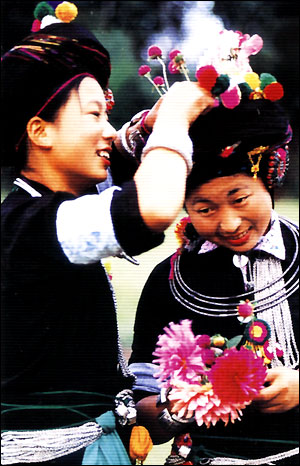Achang
Achang ethnic group
More than 90 percent of the 33,936 Achangs live in Longchuan, Lianghe and Luxi counties in the Dehong Dai-Jingpo Autonomous Prefecture in southwestern Yunnan Province. The rest live in Longling County in the neighboring Baoshan Prefecture.
These areas are on the southern tip of the Gaoligong Mountains. The climate is warm; the land fertile, crisscrossed by the Daying and Longchuan rivers and their numerous tributaries. The river valleys contain many plains, the Fusa and Lasa being the largest of them. Dense forests populated by deer, musk deer and bears cover the mountain slopes. Natural resources, such as coal, iron, copper, lead, mica and graphite, abound.
Achangs speak a language belonging to the Tibetan-Myanmese language family of the Chinese-Tibetan system. Most Achangs also can speak Chinese and the language of Dais. Their written language is Chinese.
Achangs treasure their oral culture of ballads, stories and folk tales. Singing alternating duets is a favorite evening recreation of young men and women. Musical instruments used by Achangs include the bamboo qin (a stringed plucked instrument), the bamboo flute, the gourd-shaped sheng (a wind instrument), the sanxian (a three-stringed plucked instrument), the elephant-leg drum and the gong. Drum and monkey dances are among the most popular. Handicrafts include embroidery, lacquering, dyeing, weaving, engraving and silverware making and are known for their elaborate patterns and detail. Achang engraving is extraordinary and can best be seen on furniture, buildings and Buddhist shrines, on which workers have etched vivid forms of animals and plants.
- Population: 33,936
- Major area of distribution: Yunnan
- Language: Achang
- Religion: Buddhism
Customs
Achang men tend to wear blue, white or black jackets which button down the front, although on the Lasa plain many men wear jackets with buttons toward the left side. Achang women like to wear silver objects on festive occasions. Their clothes vary somewhat depending on where they live, but in general married women wear skirts and jackets with tight sleeves and wrap their heads with black or blue cloth that may go as high as three decimeters. Unmarried women wear trousers and tie their pigtails on top of their heads. Although the habit is disappearing, young men and women used to chew areca, blackening their teeth. For food, Achangs eat rice as their staple and prefer sour dishes. They live in courtyard houses of brick or stone with wood beam supports. Achang villages are connected by gravel paths or roads paved with stone slabs.
The basic unit of the Achang society is the patriarchal, monogamous family. Young men and women are free to choose their spouses. Courting rituals are quite specific. When dusk falls, young men go to bamboo groves near the homes of the young women they desire and play the sheng to win their favor. In some places, groups of young men and women gather around a bonfire, where couples flirt by singing alternate verses. This can go on until dawn. Before 1949, marriages were arranged by parents, which often led to forced marriage and misery for unlucky young lovers. The Achangs have a strict incest taboo: people with the same surname do not marry each other. But intermarriage with Hans and Dais has always been permitted.
Under the Han influence, Achangs generally practice ancestor worship. Most Achangs on the Fusa plain believe in Hinayana, a branch of Buddhism.
Achangs generally bury their dead. In Buddhist areas, funerals are scheduled on holy days and follow the chanting of scripture by monks. One monk leads the funeral procession. As he walks, he holds a long strand of white cloth tied to the coffin, as if he were guiding the dead into the "Heavenly Kingdom." The coffin is to be carried above the heads of the close relatives of the dead, figuratively providing the deceased with a "bridge" to cross the river to the netherworld. The dead are buried without their metal ornaments; even the gold coatings on false teeth must be removed to make sure nothing will contaminate their reincarnation. Those who die of infectious diseases or childbirth are cremated.
